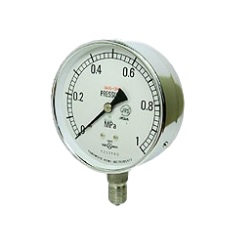(!)NOTE : Windows 7 users won’t be able to use some latest features of eCatalog/WOS since Microsoft is ending support for Windows 7 on 14 Jan, 2020. Please upgrade your system for uninterrupted services.
- Notice of End of Sales for Economy Series Pneumatic Equipment Category. More information.
Pressure Gauge(Type:Stainless Steel / Clean Pressure Gauge)
A pneumatic gauge is a gauge for measuring the pressure of gas. Pneumatic gauges vary according to pressure span, system class and size. Select according to the operating environment. Usually, the 0 point of a pneumatic gauge is the atmospheric pressure. A gauge that displays values above 0 MPa is called a pressure gauge, a gauge that displays negative pressure is called a vacuum gauge, and a gauge that can display both is called a compound gauge. Select a pressure gauge according to the fluctuation of the target pressure. Selecting an incorrect gauge may damage not only the gauge, but also the target device. For this reason, some pneumatic gauges come with safety marks to prevent damage to the target device. When used for food processing applications, an easily removable pneumatic gauge must be selected because boiling water is sometimes used for hygiene management.
Brand |
|
|---|---|
| CAD |
|
| Days to Ship |
|
1 items
- Sort By
-
You can add up to 6 items per a category to the compare list.

Stainless Steel Pressure Gauge, A Type
YAMAMOTOKEIKI
As it is made of stainless steel, it is the most suitable pressure gauge for processes with excellent corrosion resistance and atmosphere resistance.
Type Maximum Indicated Pressure(Mpa) Outer Diameter(φ) Stainless Steel / Clean Pressure Gauge 0.25 ~ 2.5 75 ~ 100 From: ₹ 6,850.04 Days to Ship: 5 Day(s) or more  5 Day(s) or more
5 Day(s) or more
| Brand |
|---|
| Product Series |
| From |
| Days to Ship |
| Type |
| Maximum Indicated Pressure(Mpa) |
| Outer Diameter(φ) |
You can add up to 6 items per a category to the compare list. | |
| Brand | YAMAMOTOKEIKI |
| Product Series | |
| From | ₹ 6,850.04 |
| Days to Ship | 5 Day(s) or more |
| Type | Stainless Steel / Clean Pressure Gauge |
| Maximum Indicated Pressure(Mpa) | 0.25 ~ 2.5 |
| Outer Diameter(φ) | 75 ~ 100 |
Loading...
Configure
Specification/Dimensions
-
Type
- General-Purpose/Standard Pressure Gauge
- Pressure Gauge W/ Color Zone
- Bottom Mount / Compact / Mount-Type Pressure Gauge
- Stainless Steel / Clean Pressure Gauge
- Pressure Gauge With Glycerin
- Other Pressure Gauge / Peripheral Accessories
-
Maximum Indicated Pressure(Mpa)
-
Outer Diameter(φ)
Related Categories to Pressure Gauge
FAQ Pressure Gauge
- Question: What is a pressure gauge?
- Answer: A pressure gauge is a tool used for measuring the pressure of fluids such as steam, water, and compressed air in a machine or piping system. It is essential to control the pressure within the standard limits. There are several units of pressure to choose from, for example, MPa, bar, kg/cm2, Psi, etc.
- Question: What types of applications are pressure gauges used in?
- Answer: Pressure gauges are most often used in various piping systems. It is used to read the pressure of fluid in pipes, for example, check steam pressure in process pipes, check the compressed air pressure in an industrial piping system, or check the oil pressure of a machine. It can also be installed
- Question: How many types of pressure gauges?
- Answer: Pressure gauges can be divided into several types, for example:
1. Pressure Gauge is a general pressure gauge. The scale always has a positive number.
2. Vacuum Gauge is a pressure gauge in a vacuum environment. The scale will have a negative number.
3. Compound Gauge is a pressure gauge that can measure pressure in normal conditions. and in a vacuum. The scale has numerical values on both the negative side and the positive side.
4. Differential Pressure Gauges are pressure gauges used to measure the pressure difference at 2 points, used for monitoring the operation of the machine system. - Question: How to choose a pressure gauge?
- Answer: Selecting a pressure gauge, there are many factors to consider, for example:
1. Determine the type of pressure such as pressure gauge, vacuum gauge, compound gauge, and differential pressure gauge
2. Determine the pressure range and pressure unit, for example, 0 to 0.1 MPa and 0 to 10 bar, and so on
3. Determine the accuracy required, for example, ±1.6%, ±5%
4. Consider the environment in which the gauge will be used for example an environment with high vibration levels, and a pressure gauge with Glycerin Bath is necessary.
5. Determine the appropriate size and connection, for example, R1/4, R1/8 and so on
6. Cost and budget - Question: Precautions in the use of pressure gauges
- Answer: 1. Check the pressure gauge. regularly that still can measure the pressure correctly or not
2. When the oil inside the pressure gauge becomes yellow or unclear, need to replace the new oil
3. Avoid installing in areas that are constantly vibration.
4. Avoid installing in high-heat and very high-humidity areas
5. Do not drop or bump it because it may damage the pressure gauge immediately
6. Do not use a pressure gauge with a lower measuring range for measuring the higher pressure





How can we improve?
How can we improve?
Thank you for your time.
Your feedback is essential for our continuous improvement
Privacy Policy
Thank you for your cooperation.
Thank you for your time.
Your feedback is essential for our continuous improvement
Please use the inquiry form.
Privacy Policy